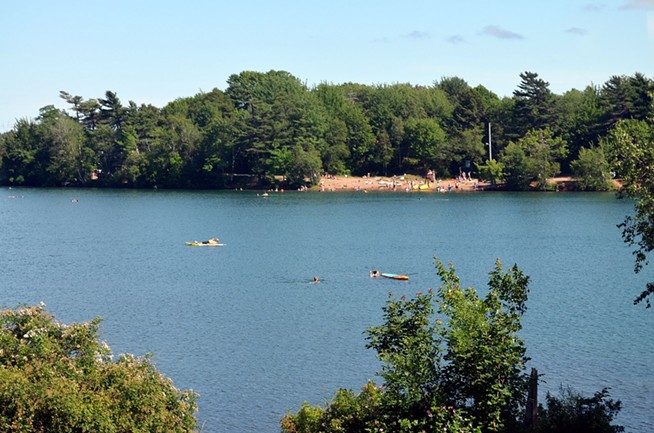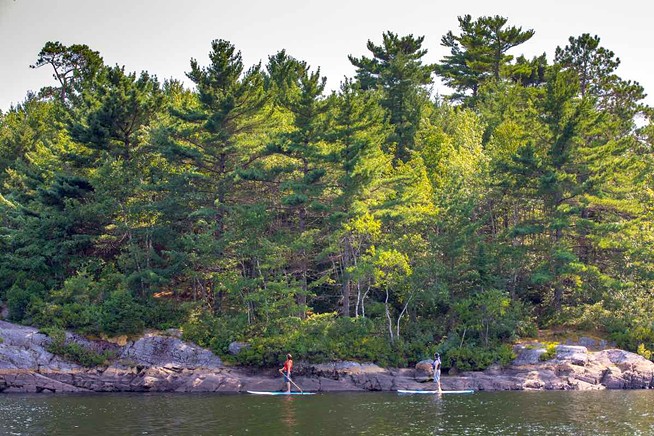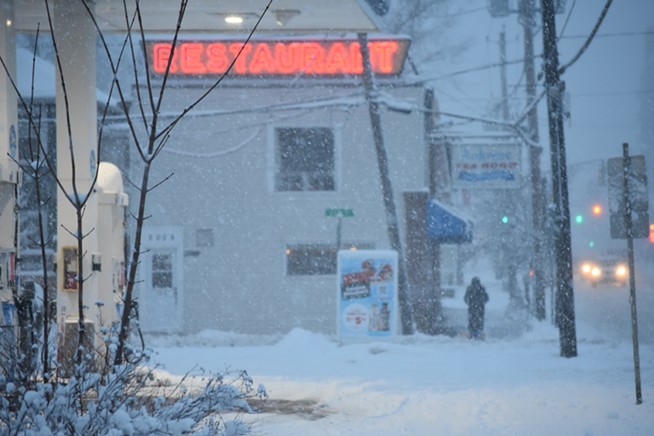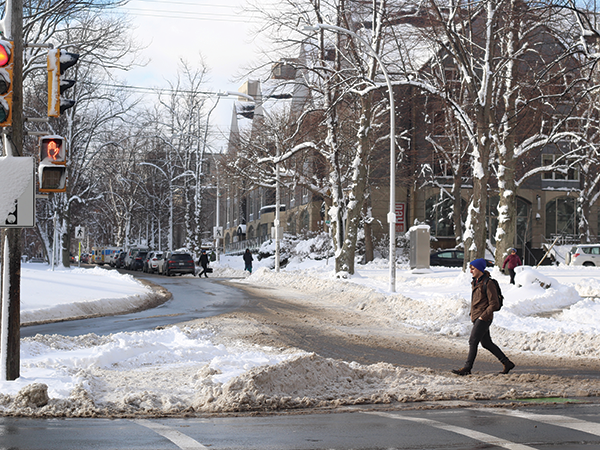Road salt lowers the risk of deadly collisions—but it’s also killing Halifax’s lakes. What’s the answer?

As Halifax heaves a final sigh of winter this weekend—with up to 20 centimetres of wet and heavy snow expected to fall—the city’s contracted road and sidewalk crews will, almost assuredly, be waiting for one last call to spring into action, plows, shovels and piles of salt at the ready.
It’s been a busy winter for them: Halifax endured historic snowstorms in January and February, turning boulevards into six-foot snow banks and streets into slippery messes. That has come at a cost—and not just to your back for all the shovelling. A growing body of research suggests that HRM’s most-used de-icing tool—road salt—is harming life in our watershed. And the degree to which road salt is affecting our lakes’ health is reaching levels we haven’t seen before.
One in five Halifax lakes has high chloride levels, study finds
Last spring, researchers at Dalhousie University’s Centre for Water Resource Studies shared a landmark report drawing on six years of water samples collected from 57 lakes across the HRM. Municipal staff collected the samples three times a year between 2006 and 2011. The findings paint a stark picture: Nearly one in five of the surveyed lakes—including Lake Banook, Chocolate Lake and Russell Lake—exceeded federal guidelines for chronic exposure to chloride, while another 15% were considered at “high risk” for reaching the exposure threshold. (The Canadian Council of Ministers of the Environment says that once a freshwater body reaches 120 milligrams of chloride per litre over longer periods, aquatic life—including fish species, invertebrates and freshwater plants—begins to fall under threat. But some researchers are starting to believe that threshold could be as much as three times lower.)
Bermarija et al., 2023. “Assessing and predicting Lake Chloride Concentrations in the Lake-Rich Urbanizing Halifax Region, Canada.” Journal of Hydrology.
Dalhousie researchers surveyed samples from 57 lakes in a six-year period and found nearly one in five exceeded federal guidelines for chronic exposure to chloride.
That’s a concern, according to Rob Jamieson. The Dalhousie professor—who supervised the 2023 report—is one of Atlantic Canada’s foremost researchers into water quality. Speaking by phone with The Coast one winter morning, he says there’s a “whole suite of effects” that begin when salt is introduced into a lake.
“Some freshwater species… just cannot tolerate increasing levels of salt within the water body,” he tells The Coast, “and what we’re seeing is that increased salt levels really impacts certain components of the food web quite significantly.”
Take zooplankton, for example: One of the bottom rungs of the aquatic food chain, the mini-crustaceans feed on phytoplankton—plant bacteria, more or less—and serve as food to a bevy of small fish and big bugs. (Winnipeg-based lake scientist Michael Paterson has called the species the “centre of the open-water food web” of most lakes.) If zooplankton die earlier and reproduce in fewer numbers in saltier lakes—as research suggests—that begins to create “knock-on effects all throughout the aquatic food web,” Jamieson says. Like a Jenga tower, enough pieces pulled from the bottom will send the whole thing tumbling.
Then, there’s the health of the water itself at issue. Research has shown high chloride levels can hinder lakes’ self-circulating ability, creating tiers of dense, salt-rich water at the bottom of lakes that can’t replenish with oxygen from the atmosphere. While in ordinary circumstances, a lake will “turn over” twice a year—in spring and fall—too much chloride can delay or “completely stop” the process, Jamieson tells The Coast.

Ben MacLeod (CC BY-SA 4.0)
Chocolate Lake is among 11 Halifax-area lakes identified as exceeding recommended chloride levels, according to a 2023 Dalhousie study.
“You end up with the salty layers of water that are at the bottom of the lake, and they’re not getting back up to the surface,” Jamieson adds. “And so they’re just sitting there, [and] all the oxygen is being depleted from those bodies of water.”
That causes its own raft of issues. (Fish, as with many life forms, need oxygen to live.)
“But also,” Jamieson says, “when you have anoxic water sitting at the bottom of the lake, it causes some geochemical reactions that release certain other contaminants from the bottom of lakes… things like phosphorus, things like arsenic.”
Long-term study finds urban development a high predictor for salt levels in lakes
Dalhousie’s 2023 study is far from the first or longest-running to link the effects of de-icing salt with Halifax’s changing lakes. For 35 years, former Dal professor Rick Scott followed the health of nine lakes throughout the HRM, before and after surrounding neighbourhoods underwent development. He started in 1982 and carried on until 2017.
Scott’s 2019 paper, published in the Journal of Environmental Management, stands alone for its longitudinal work. Among its more salient findings are that urban development is the “most significant explanatory variable” for chloride levels, and—more troublingly—that chloride lasts in Halifax’s lakes long after the region’s roads have been salted and washed away by the rain. If a lake is like a Jenga tower, then chloride might best be described as turmeric in a kitchen, or dog hair on a couch: Once it’s there, it’s not going away anytime soon.
Perhaps surprisingly, some of the longest-lasting effects can be found in watersheds when salt doesn’t wash right into a lake. When salt runoff makes its way from Halifax’s roads into forests or grasslands before ending up in the groundwater, Jamieson says, it’s possible to see higher chloride levels “for months, and sometimes even years, depending on how long it takes for that salt to travel through those hydrologic pathways.”
All of which poses a rather meaty—or in this case, briny—question: What the heck do we do about salt?
What do we do about road salt?
Councillors Sam Austin and Shawn Cleary are both well acquainted with the delicate health of Halifax’s urban lakes. As councillors for Dartmouth Centre and Halifax West Armdale, respectively, the two live in—and represent—two of the most lake-rich areas in Halifax’s urban core. (Those same districts also include some of the lakes most under threat from too much salt.) And while neither would claim to be a biologist—“as a councillor, you find yourself being a generalist in everything and an expert on nothing,” Austin tells The Coast—both have found themselves caught up in Halifax’s internal tug-of-war over how to protect the region’s urban lakes. In Cleary’s district, community efforts to protect Williams Lake led to the creation of the Shaw Wilderness Park—even if it made the Shaw Group millions in the process—and in Dartmouth’s Oathill Lake neigbourhood, Austin has played troubleshooter for keeping road salt levels low while maintaining a salted walking path on Lorne Avenue, which has no sidewalk of its own.

Nature Conservancy of Canada
Part of Halifax’s magic is that wild places like Williams Lake exist near urban spaces.
“Where we have lakes that are still vibrant, we want to keep them as vibrant as possible for as long as possible,” Cleary says, speaking by phone with The Coast.
Even still, it’s a balancing act: In Halifax’s winters—shorter though they may be—it only takes one overnight freeze after a bit of wet snow to upend our city’s fragile transportation network. In December 2016, the RCMP responded to 40 car crashes in the Halifax area on a single snowy day. A three-car crash in 2020 shut down the Macdonald Bridge.
“You have to keep people safe,” Cleary adds. “You can’t have vehicles sliding around on the road, and you can’t have people slipping on the sidewalks.”
Road salt has become almost a given in Canada in 2024. In use since the 1940s, it has proven popular for one simple reason: It works. By lowering the freezing point of water, road salt allows ice to melt in otherwise below-freezing temperatures. Canadians go through around five million tonnes every year.
But it’s not without dangers: Environment and Climate Change Canada labeled it a “toxic substance” as far back as 2001. Road salt is corrosive. And beyond its harmful effects on freshwater ecosystems, it’s a pain in the ass on our roads, sidewalks and cars.
“That’s another thing people often don’t consider,” Cleary says. “When you’re using salt, you’re degrading the concrete and asphalt, you’re degrading people’s vehicles as they’re driving around on salted roads, and especially on pedestrian-oriented main streets—I think of Quinpool—where you have buildings [opening onto the sidewalk], you’re corroding steel doors and windows and other things.”

Martin Bauman / The Coast
The Ardmore Tea Room co-owner Kelly Cormier shovels snow in front of her Quinpool Road diner on Jan. 29, 2024.
It’s not as if alternatives don’t exist. Sand is another possibility, Austin says, but there are drawbacks: Even in sand, there’s still a small amount of salt—“because as you mix it together, if you just have sand, and then you have the humidity in the sand, it clumps together. And it doesn’t actually give you the grip that you need on the road.” It also tends to blow away.
Brine is another solution, which the HRM already uses—and which Jamieson endorses. When it’s sprayed on roads before a snowstorm, it can help to reduce the need for heavier salting. As a bonus, it doesn’t have as much of a long-term negative effect as coarse salt. But smaller though the harm may be, it’s still there.
Which raises another question: As far back as 2015, HRM council resolved to have staff investigate alternative de-icers. So what happened?
The council debate
2015 was a doozy of a winter in Halifax. Hammonds Plains saw as much as 74 centimetres of snow after one March blizzard. The HRM banned on-street parking indefinitely until it could widen the roads. Snowboarders took to the streets in Dartmouth.
It was in that same winter that then-councillor Linda Mosher brought forward a motion to direct staff to “consider evaluating the best practices for management of our streets during icing conditions when salt does not work.”
“My concern is that as global warming continues, and what we’re being told are atypical winters may become the new normal … it would be great if best practices and strategies from other cities could be evaluated,” Mosher told her colleagues at HRM council’s Feb. 24, 2015 meeting.
Mosher pointed to the successes of solutions like beet juice, cheese brine, pickle brine and sugar-cane molasses as worthy of a look. Of those four, beet juice—which, like salt, lowers the freezing point of water, but unlike salt, is both non-corrosive and non-toxic—has seen the most traction, to pardon the pun. Saint John’s Harbour Bridge Authority introduced beet juice as a de-icer back in 2005—and, for the first time, saw no crashes from slippery roads in both January and February. By 2010, Montreal and Transport Quebec were experimenting with the sugary compound. Toronto had adopted a beet-juice blend in 2014.

Photo: VV Nincic via Flickr (CC BY 2.0).
The City of Toronto introduced a beet-juice blend into its winter road maintenance program in 2014.
Council agreed with Mosher’s proposal. And the HRM’s Winter Operations crew did eventually test beet juice, a municipal spokesperson tells The Coast.
But—in a Simpsons “Bolivian Tree Lizard”-esque scenario—the sugary solution created a different problem: It “attracted many rodents,” the spokesperson says. (Bring in the Chinese needle snakes!) Plus, the beet juice was sticking to people’s shoes and ending up in their homes.
Some studies have also found that a few freshwater species—mayflies, in particular—don’t respond well to the higher levels of potassium in beets.
So where does that leave us?
Switching salt diet for a road diet
There may be no perfect solution for clearing Halifax’s roads—not without significant expense, in any case. (The city could, in theory, hire more crews to plow streets and sidewalks around the clock, scraping down to the pavement after each snowfall, but that would come with a price tag.)
But there’s another possibility to explore: If Halifax can’t curb its salt use, it could extend its curbs. If, broadly speaking, the aim of road salt is road safety, then the HRM could take a page from what the University of North Carolina’s highway safety research Libby Thomas calls “one of the transportation safety field’s greatest success stories” and reclaim space from its widened collector roads and arterials for things like larger public parks, permanent patios and protected bike lanes. (Imagine, say, a genuinely car-free Spring Garden Road.) It only takes looking at Halifax after a snowfall to see how much road space could be repurposed.

Victoria Walton/The Coast
When it snows, the part of the road that cars actually use is exposed—and a lot more space for pedestrians, too.
Research shows that when cities allocate less space to cars on their roads, crashes decrease. More investment into public spaces would support the HRM’s Integrated Mobility Plan aims of “prioritizing the movement of people over vehicles” and “creating links between people and communities.” And while wider sidewalks and bike lanes would still need to be cleared of snow, every lane of road reclaimed for other uses is less salt winding up in Halifax’s lakes.
Idealistic? Maybe.
Halifax is taking small steps in that direction: The HRM slimmed down part of Prince Albert Road in an effort to slow traffic, improve stormwater drainage in the area and make it more walkable. The municipality could do with more of it—even if councillor Austin doubts a full-scale road diet is on the horizon.
“Does that change the water on the beans, as they say? I don’t think it does,” he tells The Coast. “Not in our current societal movement, anyway.”
But here’s the thing about movements: They’re not all that different from lakes, in the end. It just takes one ripple to spread.



